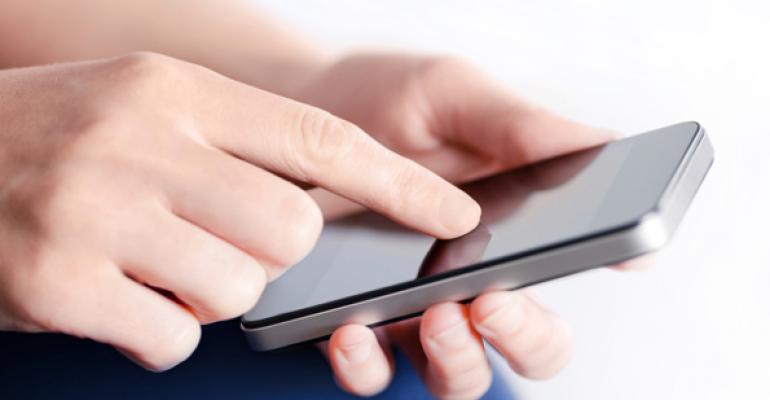Restaurant operators already have plenty of providers to consider when choosing a mobile payment solution. But the CurrentC system offered by newcomer Merchant Customer Exchange (MCX) has a couple of tantalizing features the others don’t: no credit card processing fees—funds are transferred directly from a customer’s personal bank account or other sources—and no new hardware to install. It could be a godsend for restaurants, providing customer will use it.
MCX is a consortium of some of the country’s largest corporations—mostly retailers, including WalMart and Target, but several restaurant chains are among the founders as well. MCX’s free CurrentC mobile wallet app can be downloaded now, but the system is still in testing and a full-fledged version won’t be available until the entire system goes national next year.
No question there will be plenty of places to use it. MCX’s owner-members collectively have 110,000 locations and process more than $1 trillion in payments each year. Restaurants on board include Olive Garden and all other Darden brands plus Chili’s, Wendy’s and Dunkin’ Donuts.
The general idea behind offering mobile payment systems in restaurants is that they allow customers to quickly and easily pay their tab. The benefits for operators are mostly intangible—tables turn more quickly while customers have a better overall experience.
The MCX approach differs in that its system puts the merchant’s needs first. One key benefit: Processing fees previously collected by credit card companies and banks—roughly two to three percent per transaction for most restaurants—now fall straight to the bottom line. It’s a huge factor for businesses like retailing and restaurants where margins are slim.
A second valuable perk: MCX says its users can “protect and leverage valuable data to offer customers better experiences and interactions throughout the path to purchase.” It’s a promise that makes marketers drool.
So what’s in CurrentC for customers? That’s where issues may crop up.
MCX makes using its system sounds simple enough. “CurrentC will simplify and expedite the customer checkout process by applying qualifying offers and coupons, participating merchant rewards, loyalty programs and membership accounts, and offering payment options through the consumer’s selected financial account, all with a single scan,” the company says.
However, CurrentC relies on a QR code that TechCrunch says could “seem clunky and undesirable when it finally launches.” Here’s how the website describes the process:
“When it’s time for a user to check out, they request to pay with CurrentC. The consumer then unlocks their phone, opens the CurrentC app, opens the code scanner, and scans the QR code shown on the cashier’s screen. In some case, the reverse may happen where the consumer’s CurrentC app displays a payment code and the cashier scans it. If a QR code can’t be generated, a manually entered numeric code may be offered.” Not the end of the world, but the whole works seems a lot less elegant that Apple Pay’s simple tap.
Some experts take an even-less charitable view. “QR codes. Good luck with that,” writes tech blogger John Gruber. “Plus, CurrentC doesn’t even work with credit cards — it only works with prepaid store cards and debit cards tied directly to your bank account. Apple Pay is built atop the credit card system; CurrentC is a (futile, I say) attempt to eliminate credit cards.
“What Apple gets and what no one else in the industry does is that using your mobile device for payments will only work if it’s far easier and better than using a credit card. With CurrentC, you’ll have to unlock your phone, launch their app, point your camera at a QR code, and wait. With Apple Pay, you just take out your phone and put your thumb on the Touch ID sensor.”
So how’s it going at Apple Pay, which debuted just last week? Apple boss Tim Cook told the audience at a Wall Street Journal event this week that “Apple is already the leader in ‘contactless payments,’ controlling ‘more than the total of all the other guys.’”
That total may rise even more quickly now that Apple Pay has been integrated into online reservation company OpenTable’s,Pay with Open Table mobile payment system. "With Apple Pay, OpenTable diners can skip the step of adding a card to their profile and simply settle their check with a single touch using iPhone 6 or iPhone 6 Plus,” says OpenTable c.e.o. Matt Roberts.
Other corporate giants are also at work in the mobile payment space. involved in a third take on mobile payments that’s now in place at McDonald’s. It’s a partnership involving AT&T, T-Mobile and Verizon Wireless. Earlier this week, McDonald’s announced it has rolled out tap-and-pay system Softcard, which customers can use both inside the chain’s 14,000-plus U.S. locations and at its drive-thru lane outside.
So what is Softcard? It’s “a free app that combines payments, offers and loyalty. McDonald's customers can download and use Softcard today on more than 80 mobile devices across AT&T, T-Mobile and Verizon Wireless,” the company says. “Through its use of the contactless EMV global standard and SmartTap mobile commerce technology, Softcard enables payments, offers and loyalty redemption through a simple tap.”
Customers can also use ApplePay at McDonald’s. Subway also accepts Apple Pay and Softcard payments.
No one knows which approach in the fast-moving mobile payment space will prevail. Apple backers think its friction-free system is destined to win out, but the no-credit-card-fee factor makes a powerful argument for MCX. The one thing that is clear is that with all these powerful businesses pushing mobile payment solutions, customers are going to expect you to offer something similar at your restaurant soon. Be ready.





